Voltar
ANALYSIS AND CORRELATION STUDIES OF THE ORGANIC
SOIL IN THE ECOLOGICAL RESERVE OF JURÉIA-ITATINS,
STATE OF SÃO PAULO, BRAZIL.
Attili, D. S. 1 *; Tauk-Tornisielo S.M. 2
1Fundação Tropical de Pesquisas e Tecnologia
"André Tosello", CP 1889, 13087-010,
Campinas, SP, Brazil and 2CEA-UNESP, CP 199, 13506-900,
Rio Claro, SP, Brazil.
* Present address: ESALQ-USP, CP 83, 13400-970, Piracicaba,
SP, Brazil
--------------------------------------------------------------------------------
ABSTRACT
Surface soil of three different parcels
of an area in the Ecological Reserve of Juréia-Itatins,
SP, Brazil, was sampled to determine colony-forming units
of filamentous fungi, soil moisture and pH, organic matter,
carbon and nitrogen contents (%), phosphorus (m g/cm3),
potassium, calcium and magnesium contents (meq/100 cm3),
sum of bases (meq/100 cm3), potential acidity (meq/100
cm3), cation exchange capacity (meq/100 cm3) and base
saturation (V%). The area was studied for the first time
and the parcels investigated were located next to each
other but progressively distant from the black-water Una
River, in order to verify likely influences of this distribution.
The analysis of variance and Pearson correlation coefficient
showed evidences of a high relationship between organic
matter and soil moisture content; a lower level of base
cations than acidic cations in the area; higher concentrations
of nutrients in the parcel furthest from the river, and
a positive correlation of the numbers of colony-forming
units with the elements in parcel tree. A hypothetical
outline of the nutrient distribution in the studied area
is proposed.
Key words: correlation, organic soil,
fungi filamentous, soil ecology, tropical rain forest.
--------------------------------------------------------------------------------
INTRODUCTION
Organic soils are a small portion of
the world's land area but are widely distributed. They
are formed when the production of organic matter exceeds
its mineralization, usually under conditions of almost
cetontinuous saturation with water, reducing circulation
of oxygen through the soil (5). Peat bogs, for instance,
are low pH environments that have complex organic constituents
which degrade more slowly than they accumulate. The rate
and extent of degradation of these substances vary and
depend mainly on the existance of favourable conditions
for the activity of the soil biota community (13). For
the classification of histosols it is necessary to quantitatively
evaluate the degree of the decomposition of their organic
matter. Besides the ecological aspect, their importance
also relies on the fact that bodies of histosols have
been, in many areas, sources of fuel (5).
The Atlantic tropical rain forest is
one of the most important ecosystems in the world and
comprises diverse and complex environments (12), nevertheless
only 5% of the original cover still remains in Brazil.
In the state of São Paulo, a well-preserved area
where scientific studies are nearly pioneer, can be found
in the valley of the Ribeira de Iguape river. The Ecological
Reserve of Juréia-Itatins (ERJI), SP, presents
many types of plant formations which are thought to be
the result of diverse substrates, since they are all under
the same climatic conditions. More than twenty years ago,
some natives of the ERJI cultivated rice in areas next
to the Una river which crosses the region. Soil nutrients
may be influenced by topography, parent material, disturbances
and drainage (5). Studying physico-chemical characteristics
of lowlands in the Valey of Ribeira de Iguape river, authors
(4), found different distribution patterns along the riverbed
in non-disturbed areas. This work brings information on
high organic content soil in the Atlantic rain forest
that was disturbed in the past, comparing parcels of distinct
distances from the Una river. The influence of the drainage
and the correlation among physico-chemical parameters
and number of colony forming units of filamentous fungi
are also studied aiming the characterization of the site.
MATERIAL AND METHODS
Study site
The ERJI is an area of 79.245ha Atlantic
rain forest created in 1986 and located in the State of
São Paulo, Brazil, between 24° 18’47"-24°
36’10" S and 47° 00’03" - 47°
30’07" W (Figure 1). Main climatic characteristics
are: mean air temperatures between 15-35° C, high
relative air humidity (80-100%); annual rain fall average
above 3,400mm, and a less-rainy season during autumn-winter
(3). A great variety of vegetation is found as part of
the mangroves, lowland forests, luxuriant rain forest,
mountains and elevations (7). The collecting place is
known as "Banhado Grande", in the middle of
the Reserve; in the area chosen for this study the soil
tends to peat formation and it is classified as histosol
hemist (5). The site was characterized as a secondary
forest exposed to floods, with predominance of Tibouchina
(Melastomataceae), Psychotria (Rubiaceae), Richeria australis
and Alchornea triplinervea (Euphorbiaceae), Rudgea villiflora
(Rubiaceae), Becquerelia muricata (Cyperaceae) and Calathea
sp. (Marantaceae) (Sobral, 1994, pers. commun.).
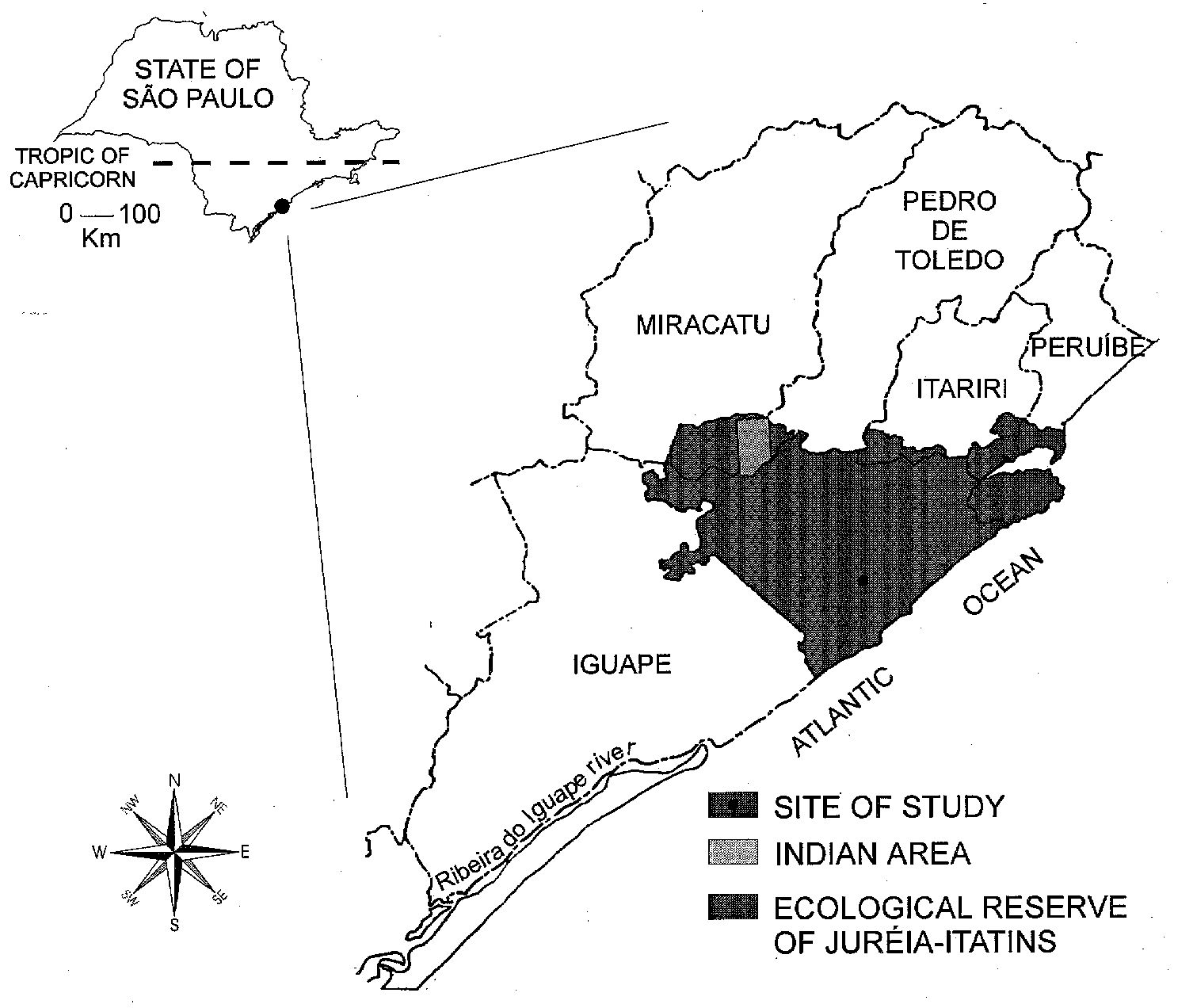
Figure 1. Localization of the Ecological Reserve of Juréia-Itatins,
SP, Brazil.
Soil sampling
From October 1990 to January 1992 surface
soil was trimonthly sampled. The 3ha. study site was established
from the left edge of the river towards the mountains.
It was subdivided in 3 parcels of the same size as follows:
parcel 1, 100m away from the river; parcel 2, 200m; parcel
3, 300m. Using sterile plastic bags, three soil samples
composed of 10 subsamples were collected from each parcel
(9 samples in total), up to the depth of 10cm after removing
the forest floor. They were labeled and homogenized. The
amount used for fungal quantification was immediately
processed and the remaining soil was sent to the Soil
Department of the Escola Superior de Agricultura "Luiz
de Queiroz", Piracicaba, where it was analysed in
five days.
Soil analysis
To determine the colony-forming units,
dilution plate counts on cellulose agar, Czapek and Fries-cellulose
modified media (9) at 28° C for 72h were used. Ten
subsamples of soil were dried at 105°C to constant
weight in order to determine moisture content. The results
of the percentage (w/w) of water in the soil were based
on the fresh weight divided by dry weight (11). Soil pH
was measured in 0.01M CaCl2 with a glass electrode.
Organic carbon was determined in 0.25g
of soil using the Walkley-Black method. Soil organic matter
and N were defined by elemental calculations. Concentrations
of extractable P were determined with a mixture of IR-120
and IRA-400 resins in a spectrophotometer. The ions K+,
Ca+2 and Mg+2 were extracted by an ion-exchange resin
procedure (after a 16-hour shaking period) and separated
from soil with an acidic solution of sodium chloride;
determination was by atomic absorption spectrophotometry.
The values of percentage base saturation, cation exchange
capacity and sum of bases were calculated. The potential
acidity was evaluated in the pH suspension comparing the
readings with a standard curve between pH values in SMP
buffer and those of potential acidity determined in soils
by the calcium acetate method (18).
Statistical analysis
Data were log transformed when appropriate
to meet the assumptions for analysis of variance (ANOVA)
(21). The average of the parameters were compared to determine
the heterogenicity of the study site. The Tukey test was
used
when differences were significative.
The analysis was performed using SAS 6.04. SYSTAT 5.01
was chosen to calculate Pearson correlation coeficients
and define relationships among colony-forming units of
filamentous fungi, soil moisture and pH, organic matter,
carbon and nitrogen contents (%), phosphorus (µg/cm3),
potassium, calcium and magnesium contents (meq/100cm3),
base cations (meq/100cm3), potential acidity (meq/100cm3),
cation exchange capacity (meq/100cm3) and base saturation
(V%).
DISCUSSION
In general, the results showed a significative
increase on the concentration of the parameters analysed,
from the distance of the river (Table 1). Lower values
were found in parcel 1 and higher ones in parcel 3, both
statistically different from parcel 2. This situation
was observed in the following parameters: colony forming
untis (1,63.103 CFU x 10,32.103 CFU); moisture content
(42,56% x 74,10%); organic matter (6,37% x 21,83%); organic
carbon content (3,70% x 12,69%) and total nitrogen content
(0,32% x 1,09%). Parcels 1 and 2 were similar in other
parameters, both significatively different from parcel
3 where higher concentrations were detected. These results
were found in the following analysis: extractable phosphorus
content (12µg Pcm-3 in parcel 2 x 39,33µg
Pcm-3 ); exchangeable potassium (0,11meq100cm-3 in parcel
1 x 0,33meq100cm-3); calcium content (0,17meq100cm-3 in
parcels 1 and 2 x 0,80meq 100cm-3); magnesium concentration
(0,20meq 100cm-3 in parcels 1 and 2 x 0,63meq 100 cm-3);
sum of bases (0,60meq100cm-3 in parcels 1 and 2 x 1,57meq100cm-3)
and CEC (11,57meq100cm-3 in parcel 1 x 34,73meq100cm-3).
Parcel 3 also presented maximum and minimum values of
two parameters: potential acidity (10,87meq100cm-3 in
May 1991 and 33,8meq100cm-3 in October 1991) and base
saturation (2,67% in October 1991 and 12% in May 1991).
The pH of all parcels varied between 3,07 and 4,03 and
were found to be indicative of an acidic soil. No statistical
differences were detected among the parcels, but measurements
of first and last samplings were statistically different.
Results of correlation analysis are in Table 2. Correlations
not significative at 5% at least were ommited. Figure
2 presents a hypothetical distribution of the parameters
studied in the sampling site.
Table 1. Number of colony forming units
of filamentous fungi, chemical and physico-chemical parameters
of the organic soil in the ERJI, SP, Brazil, analysed
between Oct.1990-Jan.1992.
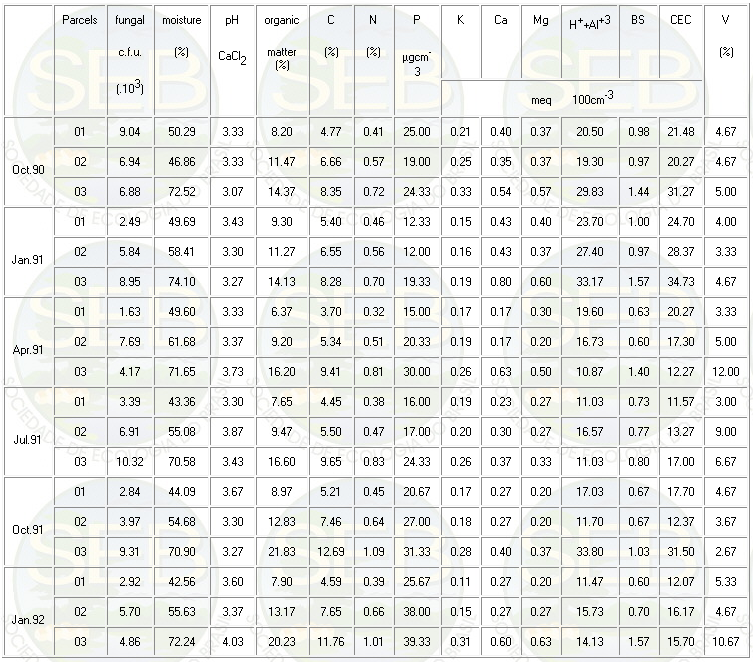
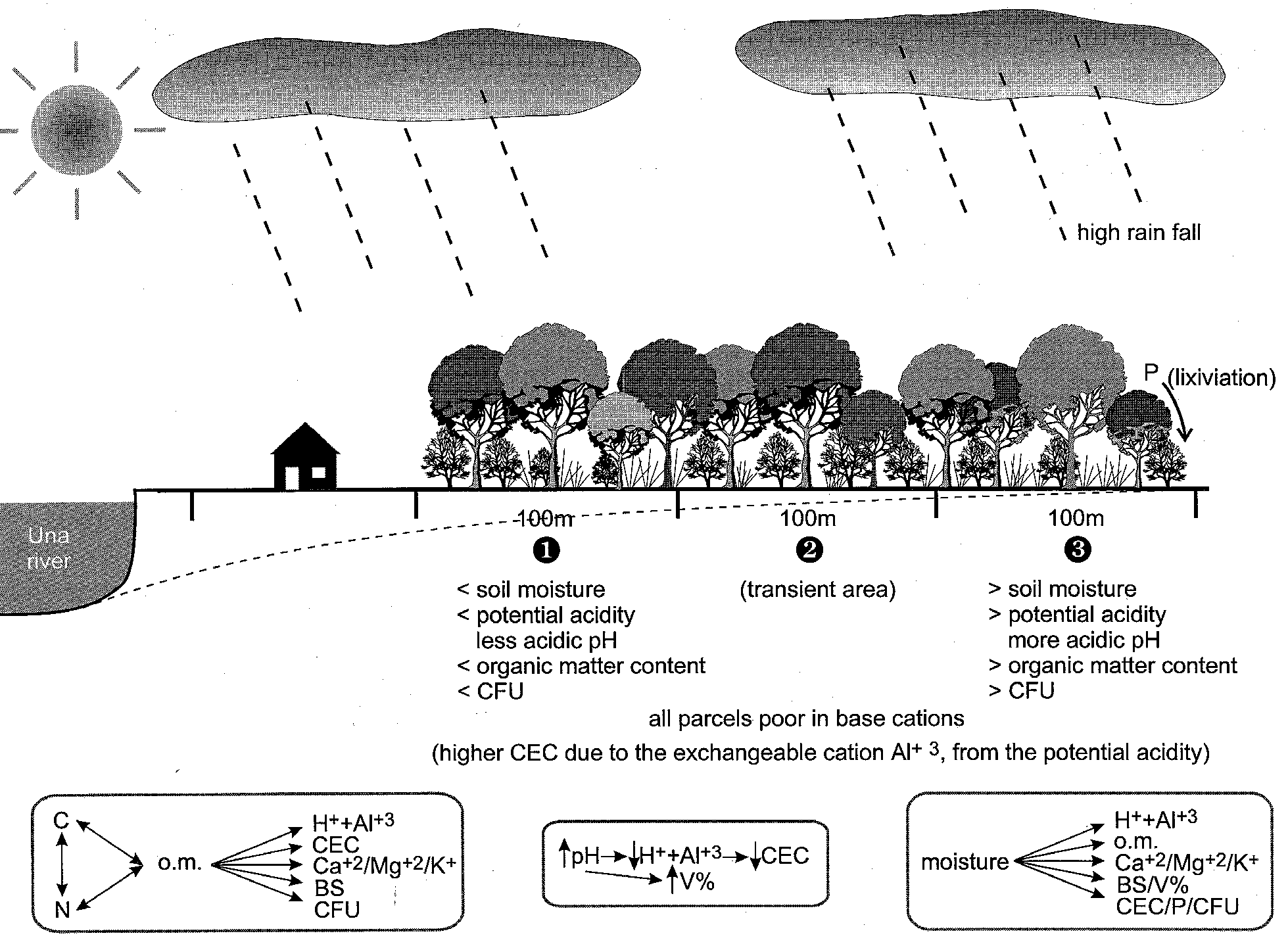
Figure 2. Hypothetical outline of the
nutrient distribution in the studied area. Legend: P =
extractable phosphorus; o.m. = organic matter; CFU = colony
forming units of filamentous fungi; CEC = cation exchange
capacity; BS = base saturation; V = sum of bases.
The moisture of the soil studied was
very high (42,5-74,1%), probably due to the total rainfall
that occurs along the year in the Atlantic Rain Forest,
where the pluviometric balance is always positive (3).
Soil moisture fluctuations in the ERJI were even higher
than other regions with similar type of vegetation where
values ranged between 50-60% for two years (20). In savannah-like
areas this percentage is much lower, around 7-17% (19).
The correlation analysis of Pearson coeficient made it
possible to highlight the importance of the water present
in the soil through many positive correlations found in
almost all parameters: organic matter, carbon, nitrogen,
potential acidity, calcium, magnesium, potassium, base
saturation, sum of the bases, CEC, extractable phosphorus
and colony forming units of filamentous fungi, Table 2.
This kind of correlation is already known because the
water and the other parameters mentioned are strictly
related (21,17). In all cases it is assumed that a higher
moisture content favoured the concentration of the cations.
The soil potential acidity is formed by the dissociation
of H+ and Al+3, which is influenced by the water content.
Besides this fact, higher values of these parameters resulted
in an increase of the number of filamentous fungi, which
usually counts for the fertility of any type of soil.
Table 2. Correlation analysis for : potencial
acidity (acidity); base saturation (BS); carbon (C); nitrogen
(N); organic matter (o. m.); pH; cation exchange capacity
(CEC); calcium (Ca+2); magnesium (Mg+2); potassium (K+);
sum of bases (V); extractable phosphorus (P); soil moisture
(moisture) and colony forming units of filamentous fungi
(CFU). Significant correlations are marked with (**) =
1% and (*) = 5%; (+) = positive correlation and (-) =
negative correlation; a = correlations .
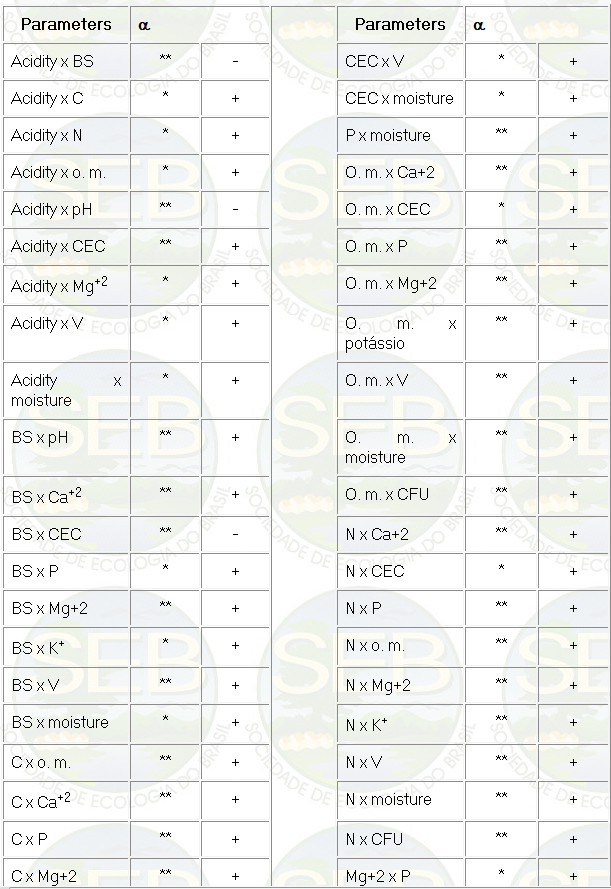
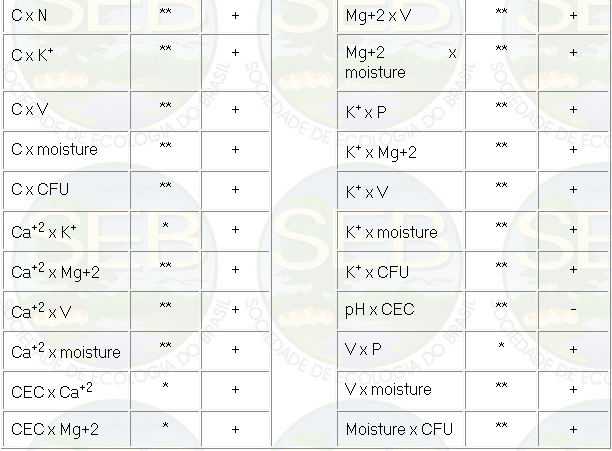
Typical of organic soils is the heavy
discharge of organic acids during the decomposition process.
This situation leads to low pH measurements, as detected
in the sampling field. In this study the pH was positively
correlated with the base saturation and was negative to
the potential acidity and CEC. In theory, when the acidity
of the soil is neutralized, a gradual decrease of the
alluminium and hidrogen is observed, resulting in lower
levels of potential acidity and higher values of pH. Since
CEC represents the sum of the bases plus H++Al+3, it decreases
as well, and then we have the negative correlation. The
relation between base saturation (sum of cations/CEC)
and the pH of the soil is very intense, so if a decrease
of the CEC occurs it is likely that the base saturation
should increase and establishe a positive correlation
with the pH (17).
Measurements of organic matter (6,4-21,8%),
total carbon (3,7-12,7%) and nitrogen (0,3-1,1%), confirmed
the status of the soil studied as organic. The predominance
of carbon content compared to the nitrogen is due to the
chemical composition of the plants (17).
The high positive correlation (1%) found
among these parameters and also similar correlations with
other analysis (potencial acidity, CEC, calcium, magnesium,
potassium, sum of bases, phosphorus and CFU of filamentous
fungi) underlines their close relationship. This fact
may be explained because it is already known that C and
N exist in soil due to the decomposition of the organic
matter (17), or as a consequence of the analytical methods
used for the determinations favouring them to express
the same fluctuations. Organic debris contribute to the
nutritional condition of the soil, releasing or keeping
nutrients due to its high CEC (4,17). Soil moisture is
related to the percentage of cellulose and hemicellulose
found in the parental organic layer which increases 4
to 6 times its capacity to retain water (10). In that
manner, the organic matter is considered one of the main
factors to establish the number of microorganisms in the
soil (17); its high correlation with sum of bases and
potential acidity in other sites nearby the ERJI was also
known (4).
The values of P concentrations measured
in the study area were considered intermediate to low,
Table 1. Despite its low rate of leaching, the lack of
this nutrient in tropical and subtropical soils had already
been mentioned (15); nevertheless, the wide variation
that phosphorus may be present in the soil makes its concentrations
range from almost zero to 3.000µg/g, depending on
the parental matter (17). All correlations determined
between P and other parameters were positive: base saturation,
sum of bases, potassium and magnesium, Table 2, which
may be a result of their proportional release from the
organic matter.
As observed for the great majority of
the parameters studied, the levels of K+ were also higher
in parcel 3, but even so the measurements of 0,11-0,33meq100cm-3
were found low to intermediate compared with other soils
in the State of São Paulo (17). Its positive correlations
with base saturation, sum of bases, calcium and magnesium
are widely reported in the literature ( 15,17).
In the study area, concentrations of
Ca+2 (0,17-0,80meq100cm-3) and Mg+2 (0,20-0,63meq 100
cm-3) were found to be very low (Lepsch, 1997, personnal
comm.), and as a consequence, the sum of bases. Soil analysis
of another area of Atlantic Rain Forest, for instance,
resulted in 1,90meq Ca+2 100cm-3 (20). In the process
of retation and cation exchange, Ca+2 is followed by Mg+2
and because of that the level of the later is usually
lower (16), as observed in this work.
In general, cation concentrations were
considered low in the soil of the studied field. It has
been observed that some plants respond with a better growth
to a favourable association of cations that leads to a
good sum than to their values individually (Sparovek,
1994, personnal comm.). Potential acidity and CEC were
positively correlated with the sum of bases.
The correlations among potential acidity,
sum of bases and magnesium suggest a proportional realease
from the organic matter, making the CEC higher. In the
association H+ + Al+3, aluminium is the only exchangeable
cation. When a smaller part of CEC is formed by basic
cations (17), then the soil becomes more acidic (CEC=
SB + H+ + Al+3) but an increase of the aluminium results
an increase of CEC too.
The parameter pH has a strong influence
on the cation exchange capacity of the organic matter.
When pH is higher, ions H+ are dissociated and free to
combain with hidroxils to make water, other cations replace
H+, increasing the CEC of the parental material (10).
CEC values of 8 different areas in the State of São
Paulo varied from 3,2 to 28,9meq100cm-3 and the organic
matter from 0,6 to 4,5% (17). Since in the organic soil
of the ERJI base cation concentrations were low it is
assumed that the levels of 11,6-34,7meq CEC 100cm-3 were
due to the exchangeable Al+3 highly present in the potential
acidity (10,9-33,8meq 100cm-3).
This study detected a negative correlation
between base saturation and potential acidity, as previously
observed by other authors in the Ribeira River Valley,
located in the surroundings of ERJI (Berg et al., 1987).
Forest soils seem likely to present this kind of correlation
since there are not practicals of soil corrections as
happens in soils used for cultivation. (Sparovek, 1994,
personnal comm.). Base saturation (Ca+2 + Mg+2 + Na+ +
K+/ CEC), is considered a very important parameter to
evaluate the fertility of a soil (16,17).
During a study of lowlands, authors (4),
concluded that areas closer to the river presented higher
levels of base saturation, lower potential acidity and
a gradual increase of organic matter and carbon further
the edge; the great complexity of this kind of environment
was highlighted. The 3ha area delimited in this investigation
was heterogeneous, and parcel 3, farther from the river
had higher levels of moisture content, organic matter
and its components. The distance may influence these parameters
because the closest parcels are subjected to a stronger
drainage, leaching the nutrients more intensively. On
the other hand, moisture content increases in parcel 3
due to a lesser draining. Base cations may be concentrated
in the canopy. Similarities between the Atlantic Rain
Forest and Amazonian Forest had already been observed
(Lepsch, 1997, personnal comm.).
Parcels 1 and 3 were always statistically
different, parcel 2 seemed to behave as a transitory area,
suggesting that major changes occur between distances
of 200m. The calculations also showed standard deviations
relatively wide, indicating that there must be microsites
in the studied area.
The diversity of elements that contribute
to the formation of soils result in differences that determine
the development of the microbial communities (2), which
in response also influence the characteristics of the
soil. Nearly half of the volume of the soil is composed
by pores fulfilled with air and water, essencial for the
survival of microorganisms; the other half is occupied
by nutrients also important for the microbial biomass
(1).
The methodology employed for the analysis
of the organic soil in the ERJI was considered appropriate
for this study, despite its simplicity. It was possible
to detect significative differences among the areas and
their influences on the number of colony forming units
of filamentous. The literature suggests that more refined
methods to analyse forest soils are still being developed.
The organic matter content, C, N, K+ and soil moisture
were correlated with the CFU
which presented higher numbers in parcel
3, where the concentration of the majority of the elements
was more elevated. However, it is assumed that the high
water content in the soil did not favour the fungal decomposition
of the organic matter as evidenced by its high content
yet to be decomposed. These microrganisms develop well
in conditions of 60-70% of soil moisture, but are also
aerobic and so more efficient in the presence of O2 which
they use as eletron receptors (14,22).
CONCLUSIONS
The moisture content of the soil directly
influenced the increase of the organic matter, and this
favoured the retention of water in the place. The organic
matter of the organic soil in the ERJI is poor in bases
and rich in acidic cations influencing the low pH found.
Increasing levels of the parameters studied were observed
from the distance of the river, with statistical differences
between 200m, revealing a higher number of colony forming
units of filamentous fungi. As mentioned before, the studied
area was a field of rice cultivation 20 years ago, and
has been recovering since then. It is known that after
removing the original vegetation of a forest there is
an interruption of the natural balance of the soil properties,
which can be restablished along the years, although in
a different way from the original condition (8). The hypothetical
outline of the parameters in the studied area proposed
in Figure 2 shows the present situation of this site.
It is assumed that despite the parcel, the content of
water in the soil was high, in general, with a hard influence
on most nutrients. Base cations must probably be concentrated
in the canopy of the secondary forest as reported in the
Amazonian forest and a lower pH may be a result of the
high potential acidity and the organic acids liberated
during the decomposition process.
ACKNOWLEDGEMENTS
DSA thanks the Conselho Nacional de Pesquisa
e Desenvolvimento - CNPq, Brasília, for the award
of a senior research grant, Dr. Fausto Campos Pires and
team, from the Environmental Secretary of the State of
São Paulo, for the assistance to reach the study
area ; Dr. Igo Lepsch, University of Uberlândia,
MG and Dr. Gerd Sparovek, ESALQ, Piracicaba, for their
suggestions and the researcher Marcos G. Sobral from the
University of Rio Grande do Sul, RS for the botanical
characterization of the study site.
--------------------------------------------------------------------------------
RESUMO
Análises e estudos das correlações
do solo orgânico na Estação Ecológica
da Juréia-Itatins, Estado de São Paulo.
Amostras de solo da superfície de três parcelas
determinadas em uma área da Estação
Ecológica de Juréia-Itatins, SP, Brasil,
foram submetidas às seguintes análises:
unidades formadoras de colônias de fungos filamentosos,
umidade, pH, matéria orgânica, nitrogênio
total, carbono (%), fósforo (µg/cm3), potássio,
cálcio e magnésio (meq/100cm3), soma das
bases (meq/100cm3), acidez potencial (meq/100cm3), capacidade
de troca catiônica (meq/100cm3) e saturação
das bases (V%). As três parcelas investigadas localizaram-se
progressivamente distantes das águas negras do
rio Una do Prelado no intuito de verificar os efeitos
desta distribuição. As análises de
variância e o coeficiente de correlação
de Pearson mostraram: 1. alta relação entre
o teor de matéria orgânica do solo e a umidade
do mesmo; 2. menores níveis de cátions básicos
em relação aos ácidos; 3. maiores
concentrações de nutrientes na parcela mais
distante do rio, e , 4. uma correlação positiva
com o número de unidades formadoras de
fungos filamentosos com o aumento de
nutrientes na parcela 3. Propõe-se um esquema hipotético
da distribuição destes elementos na área.
Palavras-chave: correlação,
ecologia do solo, floresta tropical, fungos filamentosos,
solo orgânico.
--------------------------------------------------------------------------------
REFERENCES
Alexander, M. Introduction to soil microbiology.
New York. John Wiley & Sons, 1997. 467 p.
Atlas, R. M.; Bartha, R. Microbial ecology: fundamentals
and applications., California, USA. The Benjamin/Cummings.
2 ed. 1987.533 p.
Attili, D. S.; Pinto, I. M. A. ; Zavatini, J. A. Características
climáticas da Estação Ecológica
de Juréia-Itatins, SP. Rio Claro, SP. Bol. Geogr.
Teor. 24 (47-48), 65-82, 1994.
Berg, M. van den; Lepsch, I. F.; Sakai, E. Solos de planícies
aluviais do Vale do Rio Ribeira de Iguape, SP. II. Relações
entre características físicas e químicas.
Campinas, SP, R. bras. Ci. Solo 11, 315-321, 1987.
Buol, S. W.; Hole, F. D.; Mc Cracken, R. J. Soil genesis
and classification. The Iowa State University Press, Ames.
1973, 360 p.
Cortesão, J. Juréia: a luta pela vida. Rio
de Janeiro. Index, Rio de Janeiro, RJ. 1989, 133p.
Demattê, J. L. I. Manejo de solos ácidos
dos trópicos úmidos - Região Amazônica.
Campinas, SP. Fundação Cargill, Campinas,
SP.1988. 215 p.
Ferraz, A.; Duran, N. Effect of various conditions on
the Chrysonilia sitophila "TFB 27441" growth.
Rev. Microbiol, São Paulo, SP, 20 (2), 240-245,
1989.
orge, J. A. Matéria orgânica. In: Elementos
de pedologia. Ed. A C Moniz Polígono, São
Paulo, SP. pp. 169-177, 1972.
Mclean, R. C.; Cook, W. R. I. Practical field ecology:
a guide for the Botany Departments of Universities, Colleges
and Schools. George Allen Unwin, London. 215p.
Neiman, Z. Era verde?: ecossistemas brasileiros ameaçados.
Atual (Série Meio Ambiente), São Paulo,
SP. 1989, 103 p.
Nester, E. Microbiology: dynamics and diversity. In: Microbiology:
dynamics and diversity. Eds. J J Perry & J T Staley..
Saunders College Publishing, New York, pp. 632-633. 1997.
Neves, M. C. P. Como os microrganismos obtêm energia
e nutrientes. In: Microbiologia do solo. Eds. E J B N
Cardoso, S M Tsai & M C P Neves.. Sociedade Brasileira
de Ciência do Solo, Campinas, SP. pp. 17-32, 1992.
Primavesi, A. Manejo ecológico do solo. Ed. Nobel
(6. ed), São Paulo, SP. 1984, 541 p.
Raij, B. van. Avaliação da fertilidade do
solo. Institutos da Potassa, Piracicaba, SP. 1981, 142
p.
Raij, B. van. Fertilidade do solo e adubação.
Ceres-Potafos, Piracicaba, SP. 1991, 343 p.
Raij, B. van; Quaggio J. A.Métodos de análise
de solo para fins de fertilidade. Bolm. Téc. Inst.
Agron. Campinas, SP, 81, 1-31, 1983.
Raymundo Jr., O.; Tauk-Tornisielo, S. M. Occurrence of
hyphomycetes and actinomycetes in red-yellow latosol from
a cerrado region in Brazil. Rev. Microbiol. São
Paulo, SP. 28 (3), 197-203. 1997.
Schoenlein-Crusius, I. H. Sucessão fúngica
em folhas de Alchornea triplinervia (Spreng.) M. Arg.
em ambientes aquático e terrestre, na Mata Atlântica,
Reserva Biológica do Alto da Serra de Paranapiacaba,
Santo André, SP. (Tese de Doutorado) - Instituto
de Biociências, UNESP. Rio Claro, SP. 1993. 373p.
Sokal, R. R. ; Rohfl, F. S. Biometry:
the principles and practice of statistics in biological
research. Freeman, San Francisco. 1969, 776 p.
Tsai, S. M.; Baraibar, A. V. L.; Romani, V. L. M. (1992).
Efeito de fatores do solo. In: Microbiologia do solo.
Eds. E J B N Cardoso, S M Tsai & M C P Neves.. Sociedade
Brasileira de Ciência do Solo, Campinas, SP. pp.
59-72, 1992.

